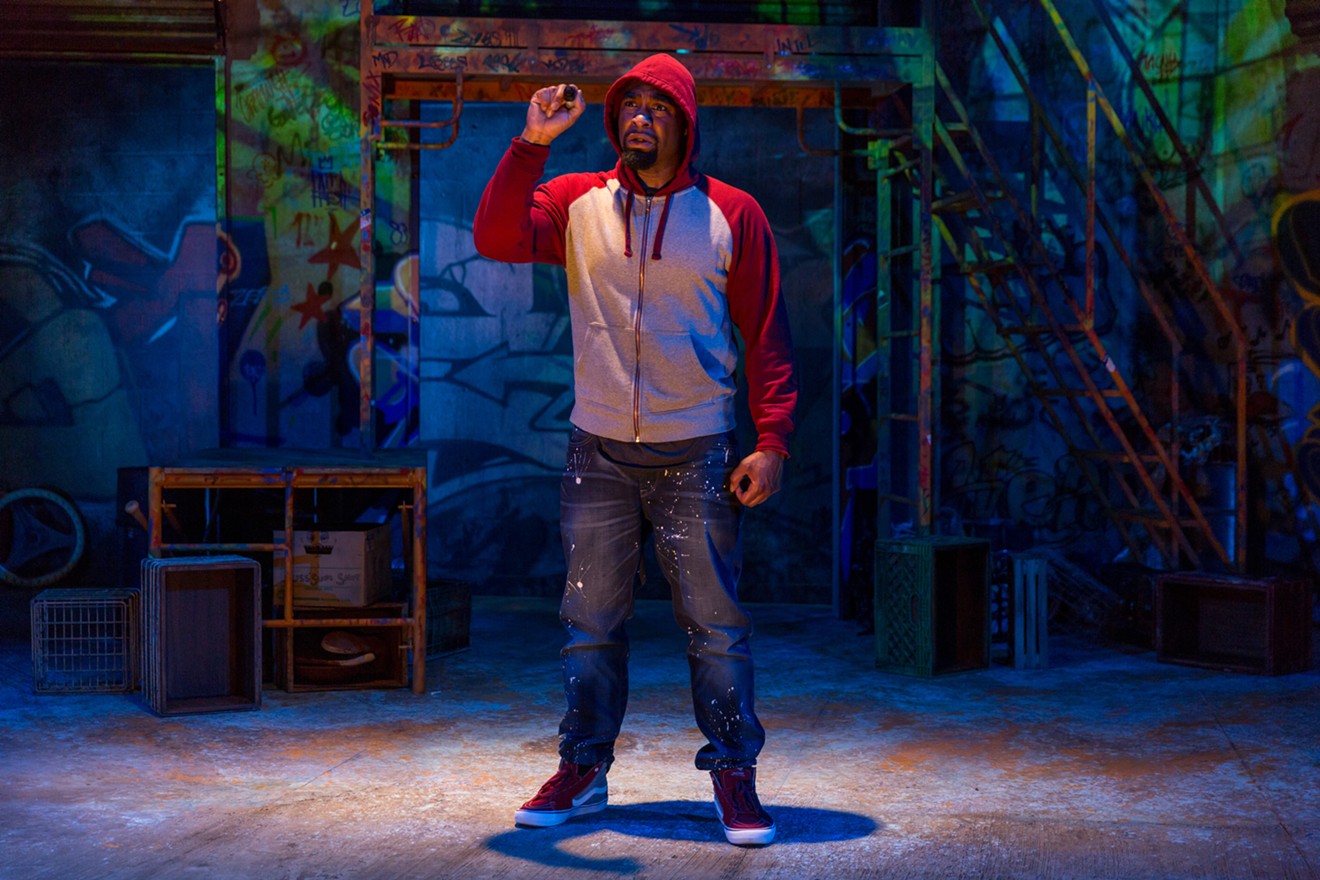The title of Kevin Coval and Idris Goodwin's play about graffiti, This Is Modern Art, states the assertion that this Off-Center@TheJones production is focused on proving. We’re introduced to three young artists: Seven (Robert Lee Hardy), Dose (Jake Mendes) and Jose Clemente (Marco Robinson). They talk street, rebellion, passion flaming up from the roots. They deliver a lecture about graffiti — history, antecedents, influential practitioners. They’re all engaging, and their lecture is interesting, but it would be equally so if you read the words on a page. With them is Selena (Chloe McLeod), a white girl in love with Seven; she has a car, drives the others from place to place and serves as lookout. Society, represented by Selena’s parents, a couple of cops and some pretentious art students — all excellently played by John Jurcheck and Brynn Tucker — is blindly uncomprehending.
The odd didacticism of This Is Modern Art is partly explained by the fact that it premiered in Chicago as part of Steppenwolf Theatre’s Young Adult series, which is intended for high-schoolers. Through its Off-Center programming, the Denver Center for the Performing Arts wants to reach out to young people, people of color, misfits and outsiders, and those who rarely or never attend plays. In the Center’s own words, it’s “about connecting unique people through out-there experiences.”
The characters in this play, however, aren’t specific, and, with a few startling and effective exceptions, their talk doesn’t seem to emanate from the lips of real people. Seven calls Selena "dear," so we know there’s something between them, but they don’t feel like a couple. They don’t eat together, share dopey jokes, get into arguments— except, of course, the big one you know has to be coming, the one that proves they can never really understand each other because their very different backgrounds and experiences create an unbridgeable gulf.
There are amazing graffiti artists in Chicago, and This Is Modern Art is based on a real event: In 2010, a team of taggers created a fifty-foot-long piece on the modern wing of the Art Institute of Chicago. Sandblasting it off later was an expensive proposition, and controversy erupted when a couple of Chicago critics questioned whether graffiti is art. It can be, suggested Chris Jones of the Tribune, but it can also be “invasive, self-important, and disrespectful of the property of others.” In the 1980s, he added, a torrent of graffiti created an atmosphere of fear in Chicago: “It terrified people.”
But what these critics ignored, the strongest element of This Is Modern Art, is how profoundly subversive graffiti can be, an explosion of power and vitality from people who usually suffer invisibility, violence and oppression. And graffiti can be a powerful political expression, as when England’s satirical Banksy slipped into Gaza three years ago and imprinted images of children swinging around a watchtower, a figure that appears to be a weeping goddess, and a kitten playing with a rusty wire ball on the ruins created by Israeli bombs.
Fortunately, the Off-Center actors are all lively and charming enough to carry the audience with them, and the set, with its swirling images and noisily banging garage doors, is very effective. The plotting starts to gather energy, too, as the three artists plan their major art-institute piece. When Seven addresses the audience directly, making us his co-conspirators, anticipation runs through the theater. We’re about to be exposed — symbolically, at least — to the risks real graffiti artists face. How will Seven, Dose and Jose Clemente pull it off? Will they hand us spray cans? Invite us to brainstorm ideas or actually create some work? Unfortunately, nothing like that happens, and we’re soon back to being mere observers.
While the topic may be subversive, this play just isn’t. We can admire the committed acting, the one magnificently staged death, the tech that produces all those lively images, but there’s no real tension or mental disruption here. The day Seven leads us outside the building to tag a wall, we’ll begin to understand what Coval and Goodwin want to communicate.
This Is Modern Art, presented by the Denver Center for the Performing Arts Off-Center@TheJones through April 15, 303-893-4100, denvercenter.org.
[
{
"name": "Air - MediumRectangle - Inline Content - Mobile Display Size",
"component": "12017618",
"insertPoint": "2",
"requiredCountToDisplay": "2"
},{
"name": "Editor Picks",
"component": "17242653",
"insertPoint": "4",
"requiredCountToDisplay": "1"
},{
"name": "Inline Links",
"component": "18838239",
"insertPoint": "8th",
"startingPoint": 8,
"requiredCountToDisplay": "7",
"maxInsertions": 25
},{
"name": "Air - MediumRectangle - Combo - Inline Content",
"component": "17261320",
"insertPoint": "8th",
"startingPoint": 8,
"requiredCountToDisplay": "7",
"maxInsertions": 25
},{
"name": "Inline Links",
"component": "18838239",
"insertPoint": "8th",
"startingPoint": 12,
"requiredCountToDisplay": "11",
"maxInsertions": 25
},{
"name": "Air - Leaderboard Tower - Combo - Inline Content",
"component": "17261321",
"insertPoint": "8th",
"startingPoint": 12,
"requiredCountToDisplay": "11",
"maxInsertions": 25
}
]












